Plant Hormone Protocols (Methods in Molecular Biology) 0896035778, 9780896035775
Established investigators from around the world describe in step-by-step detail their best techniques for the study of p
146 70 3MB
English Pages 216 [201] Year 2000
Recommend Papers
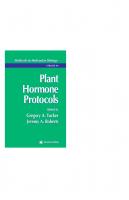
- Author / Uploaded
- Gregory A. Tucker (editor)
- Jeremy A. Roberts (editor)
File loading please wait...
Citation preview
Tucker Roberts
Methods in Molecular Biology
TM
VOLUME 141
Plant Hormone Protocols
Plant Hormone Protocols Edited by
Gregory A. Tucker Jeremy A. Roberts
HUMANA PRESS
Humana
9/4/07, 10:12 AM
Plant Hormone Protocols
METHODS IN MOLECULAR BIOLOGY
TM
John M. Walker, SERIES EDITOR 141. Plant Hormone Protocols, edited by Gregory A. Tucker and Jeremy A. Roberts, 2000 140. Chaperonin Protocols, edited by Christine Schneider, 2000 139. Extracellular Matrix Protocols, edited by Charles Streuli and Michael Grant, 2000 138. Chemokine Protocols, edited by Amanda E. I. Proudfoot, Timothy N. C. Wells, and Christine Power, 2000 137. Developmental Biology Protocols, Volume III , edited by Rocky S. Tuan and Cecilia W. Lo, 2000 136. Developmental Biology Protocols, Volume II, edited by Rocky S. Tuan and Cecilia W. Lo, 2000 135. Developmental Biology Protocols, Volume I, edited by Rocky S. Tuan and Cecilia W. Lo, 2000 134. T Cell Protocols: Development and Activation, edited by Kelly P. Kearse, 2000 133. Gene Targeting Protocols, edited by Eric B. Kmiec, 2000 132. Bioinformatics Methods and Protocols, edited by Stephen Misener and Stephen A. Krawetz, 2000 131. Flavoprotein Protocols, edited by S. K. Chapman and G. A. Reid, 1999 130. Transcription Factor Protocols, edited by Martin J. Tymms, 2000 129. Integrin Protocols, edited by Anthony Howlett, 1999 128. NMDA Protocols, edited by Min Li, 1999 127. Molecular Methods in Developmental Biology: Xenopus and Zebrafish, edited by Matthew Guille, 1999 126. Adrenergic Receptor Protocols, edited by Curtis A. Machida, 2000 125. Glycoprotein Methods and Protocols: The Mucins, edited by Anthony P. Corfield, 2000 124. Protein Kinase Protocols, edited by Alastair D. Reith, 2000 123. In Situ Hybridization Protocols (2nd ed.), edited by Ian A. Darby, 2000 122. Confocal Microscopy Methods and Protocols, edited by Stephen W. Paddock, 1999 121. Natural Killer Cell Protocols: Cellular and Molecular Methods, edited by Kerry S. Campbell and Marco Colonna, 2000 120. Eicosanoid Protocols, edited by Elias A. Lianos, 1999 119. Chromatin Protocols, edited by Peter B. Becker, 1999 118. RNA–Protein Interaction Protocols, edited by Susan R. Haynes, 1999 117. Electron Microscopy Methods and Protocols, edited by M. A. Nasser Hajibagheri, 1999 116. Protein Lipidation Protocols, edited by Michael H. Gelb, 1999 115. Immunocytochemical Methods and Protocols (2nd ed.), edited by Lorette C. Javois, 1999 114. Calcium Signaling Protocols, edited by David G. Lambert, 1999 113. DNA Repair Protocols: Eukaryotic Systems, edited by Daryl S. Henderson, 1999 112. 2-D Proteome Analysis Protocols, edited by Andrew J. Link, 1999 111. Plant Cell Culture Protocols, edited by Robert D. Hall, 1999 110. Lipoprotein Protocols, edited by Jose M. Ordovas, 1998 109. Lipase and Phospholipase Protocols, edited by Mark H. Doolittle and Karen Reue, 1999 108. Free Radical and Antioxidant Protocols, edited by Donald Armstrong, 1998
107. Cytochrome P450 Protocols, edited by Ian R. Phillips and Elizabeth A. Shephard, 1998 106. Receptor Binding Techniques, edited by Mary Keen, 1999 105. Phospholipid Signaling Protocols, edited by Ian M. Bird, 1998 104. Mycoplasma Protocols, edited by Roger J. Miles and Robin A. J. Nicholas, 1998 103. Pichia Protocols, edited by David R. Higgins and James M. Cregg, 1998 102. Bioluminescence Methods and Protocols, edited by Robert A. LaRossa, 1998 101. Mycobacteria Protocols, edited by Tanya Parish and Neil G. Stoker, 1998 100. Nitric Oxide Protocols, edited by Michael A. Titheradge, 1998 99. Stress Response: Methods and Protocols, edited by Stephen M. Keyse, 2000 98. Forensic DNA Profiling Protocols, edited by Patrick J. Lincoln and James M. Thomson, 1998 97. Molecular Embryology: Methods and Protocols, edited by Paul T. Sharpe and Ivor Mason, 1999 96. Adhesion Protein Protocols, edited by Elisabetta Dejana and Monica Corada, 1999 95. DNA Topoisomerases Protocols: II. Enzymology and Drugs, edited by Mary-Ann Bjornsti and Neil Osheroff, 2000 94. DNA Topoisomerases Protocols: I. DNA Topology and Enzymes, edited by Mary-Ann Bjornsti and Neil Osheroff, 1999 93. Protein Phosphatase Protocols, edited by John W. Ludlow, 1998 92. PCR in Bioanalysis, edited by Stephen J. Meltzer, 1998 91. Flow Cytometry Protocols, edited by Mark J. Jaroszeski, Richard Heller, and Richard Gilbert, 1998 90. Drug–DNA Interaction Protocols, edited by Keith R. Fox, 1998 89. Retinoid Protocols, edited by Christopher Redfern, 1998 88. Protein Targeting Protocols, edited by Roger A. Clegg, 1998 87. Combinatorial Peptide Library Protocols, edited by Shmuel Cabilly, 1998 86. RNA Isolation and Characterization Protocols, edited by Ralph Rapley and David L. Manning, 1998 85. Differential Display Methods and Protocols, edited by Peng Liang and Arthur B. Pardee, 1997 84. Transmembrane Signaling Protocols, edited by Dafna Bar-Sagi, 1998 83. Receptor Signal Transduction Protocols, edited by R. A. John Challiss, 1997 82. Arabidopsis Protocols, edited by José M Martinez-Zapater and Julio Salinas, 1998 81. Plant Virology Protocols: From Virus Isolation to Transgenic Resistance, edited by Gary D. Foster and Sally Taylor, 1998 80. Immunochemical Protocols (2nd. ed.), edited by John Pound, 1998 79. Polyamine Protocols, edited by David M. L. Morgan, 1998 78. Antibacterial Peptide Protocols, edited by William M. Shafer, 1997 77. Protein Synthesis: Methods and Protocols, edited by Robin Martin, 1998 76. Glycoanalysis Protocols (2nd. ed.), edited by Elizabeth F. Hounsell, 1998
METHODS IN MOLECULAR BIOLOGY
Plant Hormone Protocols Edited by
Gregory A. Tucker and
Jeremy A. Roberts School of Biological Sciences, University of Nottingham, UK
Humana Press
Totowa, New Jersey
TM
© 2000 Humana Press Inc. 999 Riverview Drive, Suite 208 Totowa, New Jersey 07512 All rights reserved. No part of this book may be reproduced, stored in a retrieval system, or transmitted in any form or by any means, electronic, mechanical, photocopying, microfilming, recording, or otherwise without written permission from the Publisher. Methods in Molecular Biology™ is a trademark of The Humana Press Inc. All authored papers, comments, opinions, conclusions, or recommendations are those of the author(s), and do not necessarily reflect the views of the publisher. This publication is printed on acid-free paper. ' ANSI Z39.48-1984 (American Standards Institute) Permanence of Paper for Printed Library Materials. Cover design by Patricia F. Cleary. For additional copies, pricing for bulk purchases, and/or information about other Humana titles, contact Humana at the above address or at any of the following numbers: Tel.: 973-256-1699; Fax: 973-256-8341; E-mail: [email protected]; Website: http://humanapress.com Photocopy Authorization Policy: Authorization to photocopy items for internal or personal use, or the internal or personal use of specific clients, is granted by Humana Press Inc., provided that the base fee of US $10.00 per copy, plus US $00.25 per page, is paid directly to the Copyright Clearance Center at 222 Rosewood Drive, Danvers, MA 01923. For those organizations that have been granted a photocopy license from the CCC, a separate system of payment has been arranged and is acceptable to Humana Press Inc. The fee code for users of the Transactional Reporting Service is: [0-89603-577-8/00 $10.00 + $00.25]. Printed in the United States of America. 10 9 8 7 6 5 4 3 2 1 Library of Congress Cataloging in Publication Data Plant hormone protocols / Gregory A. Tucker and Jeremy A. Roberts. p. cm. -- (Methods in molecular biology ; v. 141) Includes bibliographical references (p. ). ISBN 0-89603-577-8 (alk. paper) 1. Plant hormones. I. Tucker, G. A. (Gregory A. ) II. Roberts, J. A. (Jeremy A. ) III. Series. QK898.H67 P63 2000 571.7'42--dc21 99-058889
Preface Plant scientists have been aware for over 50 years that minute amounts of a group of compounds termed hormones or growth regulators can have a profound effect on differentiation and development. As the years have gone by, increasingly sophisticated approaches have been developed to determine the concentrations of these chemicals in plant tissues and cells, and Plant Hormone Protocols seeks to provide a “state-of-the-art” account of these techniques. What is clear is that in addition to knowing the amounts of plant hormone molecules, we also need to know how they are produced and how they bring about their effects. Consequently, we have also included contemporary approaches for the identification of the biosynthetic pathways of plant hormones, the receptors with which they interact, and the possible signaling systems by which they exert their effects. We have not aimed to cover these different aspects with every plant hormone, but rather have chosen particularly powerful strategies that we believe will be appropriate in our quest to understand how the concentrations of these compounds are regulated and how they may bring about some of the responses that are observed. We are confident that with the advent of new approaches in molecular biology and transgenic technology the next five years will see an explosion in information relating to these aspects of plant science. Gregory A. Tucker Jeremy A. Roberts
v
Contents Preface ............................................................................................................. v Contributors ..................................................................................................... ix 1 Extraction and Purification of an Enzyme Potentially Involved in ABA Biosynthesis Gregory A. Tucker, Pete Bass, and Ian Taylor .................................. 1 2 Differential Display: Analysis of Gene Expression During Plant Development Catherine A. Whitelaw, Benedetto Ruperti, and Jeremy A. Roberts ................................................................... 19 3 Abscisic Acid: ABA Immunoassay and Gas Chromatography/Mass Spectrometry Verification M. K. Walker-Simmons, Patricia A. Rose, Lawrence R. Hogge, and Suzanne R. Abrams ................................................................. 33 4 Auxin Analysis Els Prinsen, Stijn Van Laer, Sevgi Öden, and Henri Van Onckelen ................................................................. 49 5 Photoacoustic and Photothermal Detection of the Plant Hormone Ethylene Laurentius A. C. J. Voesenek, Frans J. M. Harren, Hugo S. M. de Vries, Cor A. Sikkens, Sacco te Lintel Hekkert, and Cornelius W. P. M. Blom ......................................................... 67 6 Analysis of Gibberellins Stephen J. Croker and Peter Hedden ................................................ 93 7 Cytokinins: Extraction, Separation, and Analysis Paula E. Jameson, Huaibi Zhang, and David H. Lewis ................. 101 8 Binding Studies Michael A. Venis ................................................................................ 123 9 Mutagenesis Ottoline Leyser ................................................................................... 133
vii
viii
Contents
10 The Identification of Ethene Biosynthetic Genes by Gene Silencing: Antisense Transgenes, Agrobacterium-Mediated Transformation, and the Tomato ACC Oxidase cDNA Grantley W. Lycett ............................................................................. 145 11 Extraction, Separation, and Analysis of Plant Phosphoinositides and Complex Glycolipids Bjørn K. Drøbak, Nicholas J. Brewin, and Luis E. Hernandez .................................................................. 157 12 Reverse Genetics: Screening Plant Populations for Gene Knockouts Sean T. May, Deborah Clements, and Malcolm J. Bennett ................................................................ 175 Index ............................................................................................................ 197
Contributors SUZANNE R. ABRAMS • Plant Biotechnology Institute, National Research Council of Canada, Saskatoon, Canada PETE BASS • School of Biological Sciences, University of Nottingham, UK MALCOLM J. BENNETT • School of Biological Sciences, University of Nottingham, UK CORNELIUS W. P. M. BLOM • Department of Ecology, University of Nijmegen, Nijmegen, The Netherlands. NICHOLAS J. BREWIN • Department of Genetics, John Innes Centre, Norwich Research Park, Colney, Norwich, UK DEBORAH CLEMENTS • School of Biological Sciences, University of Nottingham, UK STEPHEN J. CROKER • Department of Agricultural Sciences, IARC-Long Ashton Research Station, University of Bristol, Long Ashton, Bristol, UK HUGO S. M. DE VRIES • ATO-DLO, Wageningen, The Netherlands BJØRN K. DRØBAK • Cell Signalling Group, Department of Cell Biology, John Innes Centre, Norwich Research Park, Colney, Norwich, UK FRANS J. M. HARREN • Department of Molecular and Laser Physics, University of Nijmegen, Nijmegen, The Netherlands PETER HEDDEN • Department of Agricultural Sciences, IARC-Long Ashton Research Station, University of Bristol, Long Ashton, Bristol, UK SACCO TE LINTEL HEKKERT • Department of Molecular and Laser Physics, University of Nijmegen, Nijmegen, The Netherlands LUIS E. HERNANDEZ • Laboratory of Plant Physiology, Edificio de Biológicas, Universidad Autónoma de Madrid, Madrid, Spain LAWRENCE R. HOGGE • Plant Biotechnology Institute, National Research Council of Canada, Saskatoon, Canada PAULA E. JAMESON • Institute of Molecular BioSciences, College of Sciences, Massey University, Palmerston North, New Zealand DAVID H. LEWIS • New Zealand Institute for Coop and Food Research, Palmerston North, New Zealand OTTOLINE LEYSER • The Plant Laboratory, Department of Biology, University of York, Heslington, UK
ix
x
Contributors
GRANTLEY W. LYCETT • School of Biological Sciences, University of Nottingham, UK SEAN T. MAY • School of Biological Sciences, University of Nottingham, UK SEVGI ÖDEN • Department of Biology, University of Antwerp (UIA), Antwerpen, Belgium ELS PRINSEN • Department of Biology, University of Antwerp (UIA), Antwerpen, Belgium JEREMY A. ROBERTS • School of Biological Sciences, University of Nottingham, UK PATRICIA A. ROSE • Plant Biotechnology Institute, National Research Council of Canada, Saskatoon, Canada BENEDETTO RUPERTI • School of Biological Sciences, University of Nottingham, UK COR A. SIKKENS • Department of Molecular and Laser Physics, University of Nijmegen, Nijmegen, The Netherlands IAN TAYLOR • School of Biological Sciences, University of Nottingham, UK GREGORY A. TUCKER • School of Biological Sciences, University of Nottingham, UK STIJN VAN LAER • Department of Biology, University of Antwerp (UIA), Antwerpen, Belgium HENRI VAN ONCKELEN • Department of Biology, University of Antwerp (UIA), Antwerpen, Belgium MICHAEL A. VENIS • Horticulture Research International, Wellesbourne, Warwick, UK LAURENTIUS A. C. J. VOESENEK • Plant Ecophysiology, Faculty of Biology, Utrecht University, Utrecht, The Netherlands. M. K. WALKER-SIMMONS • Agriculture Research Service, Washington State University, US Department of Agriculture, Pullman, WA CATHERINE A. WHITELAW • Agriculture Research Service SARL, US Department of Agriculture, Beltsville, MD HUAIBI ZHANG • The Horticulture and Food Research Institute of New Zealand, Palmerston North, New Zealand
Extraction and Purification of Enzymes
1 Extraction and Purification of an Enzyme Potentially Involved in ABA Biosynthesis Gregory A. Tucker, Pete Bass, and Ian Taylor
1. Introduction The advent of genetic engineering has provided a means to manipulate the biosynthesis of plant hormones to the advantage of agriculture. Such manipulation is very dependent on a detailed knowledge of the biosynthetic pathways involved in the production of the hormones, and more precisely about the enzymes involved in this biosynthesis. The knowledge of enzymes assists, but is not always a prerequisite for, the isolation of the genetic material, usually cDNAs, used as the genetic tools to manipulate hormone synthesis. The first such example of the manipulation of hormone biosynthesis by the application of genetic engineering was for the hormone ethene. The biosynthetic pathway for ethene was first described in apples by Adams and Yang (1). Methionine was found to be the precursor of this hormone in plant tissue and is converted via S-adenysyl-methionine (SAM) into the unique compound 1-amino-1-carboxyl cyclopropane (ACC). The conversion of SAM into ACC is carried out by a key biosynthetic enzyme, ACC synthase, and the subsequent conversion of ACC into ethene is carried out by a second enzyme, namely ACC oxidase. These two enzymes From: Methods in Molecular Biology, vol. 141: Plant Hormone Protocols Edited by: G. A. Tucker and J. A. Roberts © Humana Press Inc., Totowa, NJ
1
1
2
Tucker, Bass, and Taylor
have been extensively studied and cDNAs for both identified, although by completely different methods. ACC oxidase cDNA was initially identified by a process of differential screening of a tomatoripening cDNA library. This technique was used to identify cDNA clones from a library made from ripe tomato, which are exclusively expressed in a ripe fruit but not a green fruit. Since the biosynthesis of ethene was known to be ripening specific, it was postulated that at least some of any clones identified would encode biosynthetic enzymes. The technique identified several clones, one of which, pTOM13, appeared to have expression closely correlated with ethene synthesis. The use of this cDNA to transform tomato plants with an antisense gene resulted in genetically manipulated plants with lowered ethene production and a correspondingly reduced ability to convert ACC to ethene (2). It was thus postulated that the pTOM13 cDNA encoded the enzyme ACC oxidase, a conclusion further supported by the observation that yeast genetically engineered with pTOM13 cDNA acquired the ability to convert ACC to ethene (3). The sequence analysis of the pTOM 13 cDNA suggested a close relationship between the ACC oxidase and flavonone oxidase enzymes. This information enabled Ververdis and John (4) to successfully extract the ACC oxidase enzyme and carry out its purification and characterization. The isolation of a cDNA encoding ACC synthase was achieved by a different route. In this instance the enzyme itself was first extracted and partially purified, and then an antibody was raised against the protein. Using this antibody a cDNA expression library was screened and the corresponding cDNA isolated (5). The identity of the cDNA was confirmed by the expression of ACC synthase activity in Escherichia coli transformed with the cDNA (5). This cDNA has been used to construct an antisense gene, which has in turn been used to silence members of the endogenous ACC synthase gene family and bring about a marked reduction in ethene synthesis in transgenic plants (6). The resultant plants showed
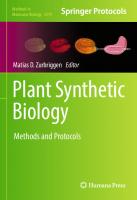
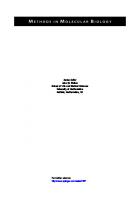
![Plant Embryo Culture: Methods and Protocols (Methods in Molecular Biology,710) [1st Edition.]
1617379875, 9781617379871](https://ebin.pub/img/200x200/plant-embryo-culture-methods-and-protocols-methods-in-molecular-biology710-1st-edition-1617379875-9781617379871.jpg)
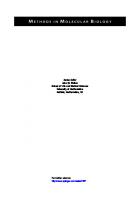
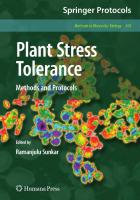


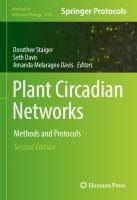

![Plant Reverse Genetics: Methods and Protocols (Methods in Molecular Biology) [1st Edition.]
1607616815, 9781607616818](https://ebin.pub/img/200x200/plant-reverse-genetics-methods-and-protocols-methods-in-molecular-biology-1st-edition-1607616815-9781607616818.jpg)